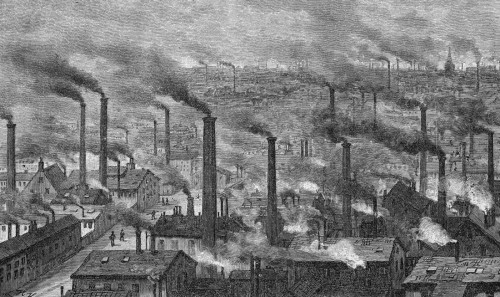'The murderous, meaningless caprices of fashion': Marx on capital, clothing and fashion

Esther Leslie traces Marx's analysis of clothing and fashion under capitalism.
There are rhythms in capitalism, which those critics more or less proximate to the Marxist tradition - say, Walter Benjamin, Georg Simmel, Roland Barthes, Elizabeth Wilson - have seen repeated in the rhythms of fashion. Fashion and capitalism alike are reliant on change and the production of newness. Fashion stimulates consumption, which is why Werner Sombart declared it ‘capitalism’s favourite child’. Yet, some time before, in 1690, Nicholas Barbon proposed a mutual relation between fashion and economy:
In some places, it is fixt and certain; as all over Asia, and in Spain; but in France, England, and other places, the Dress alters; Fashion or the alteration of Dress, is a great Promoter of Trade, because it occasions the Expence of Cloaths, before the Old ones are worn out: It is the Spirit and Life of Trade; It makes a Circulation, and gives a Value by Turns, to all sorts of Commodities; keeps the great Body of Trade in Motion; it is an Invention to Dress a Man, as if he lived in a perpetual Spring; he never sees the Autum of his Cloaths.
Marx was a reader of the financial speculator Barbon, or Bare Bones as he was sometimes known. He quoted him in the opening pages of Capital in discussing the ‘wants of the mind’. For Marx, the capitalist mode of production and consumption demands perpetual innovation, variation, suspension. This is how Marx and Engels characterised it from the beginning of their writing partnership. The Communist Manifesto (1848) contains one of their most cited phrases: ‘All that is solid melts into air’. Capitalism requires continual newness, if only to keep sales buoyant, for its cellular unit is the commodity. Fashion is the mechanism whereby novelty is delivered. As mode, it epitomises this constant churn, this endless stimulus to production and consumption.

Marx’s opinion of fashion as an industry appears to be completely negative. Fashion’s configuration of seasonal and quixotic variation is an emblem of the breakneck pace and sudden readjustments of industrial capitalist production, which Capital indicts with the following words: ‘The murderous, meaningless caprices of fashion’. These bring about the hiring and firing of workers at whim, and are associated with a general ‘anarchy’ of capitalist production. Marx mentions ‘the season’ with its ‘sudden placing of large orders that have to be executed in the shortest possible time.’
The advent of railways and telegraphs exacerbates this. Marx quotes a manufacturer on purchasers who travel fortnightly from Glasgow, Manchester, and Edinburgh to the wholesale warehouses supplied by his factory. Instead of buying from stock as before, they give small orders requiring immediate execution: ‘Years ago we were always able to work in the slack times, so as to meet demand of the next season, but now no-one can say beforehand what will be the demand then.’ Work and income are reliant on on fashion’s fancies. The irony is that those labouring for the season are manufacturing luxury materials, working with silk, for example, while the workers are outfitted in rags, scraps of cloth that have been clothes for so long they scarcely hold together.

The textile industry installs the factory system of exploitation (as an aside, note that twists of etymology track from the German word for factory – Fabrik – to the English word for woven or otherwise processed cloth - fabric). The significance, alongside steam power and iron founding, of textile manufacture and processing in the first Industrial Revolution - automated cotton, worsted and yarn spinning in factories - is testament to the central role within industrial capitalism of cloth manufacture. Engels knew the textile industry well, as his father was a cotton manufacturer. He provided Marx with the awful details. Underneath fashion lies exploitation. In the cotton mills of mid-nineteenth century Britain, men, women, and children laboured cheaply, six days a week, spinning materials harvested by slaves in the US. In the silk mills, child labour was abusive: ten-hour shifts and the exemption from otherwise compulsory education. The necessary light touch when working with delicately textured silk was apparently only acquired by early introduction to this work.
Marx details how, in 1850, the Factory Acts attempted to restrict some of the worst practices, but certain trades were excluded from the legislation. Dye and bleach works came under the provision of the Act only in 1860, lace and stocking manufacturers in 1861. The 1860 Act pronounced that, for dye and bleach works, the working-day be twelve hours long from August 1861, and from August 1862, ten hours, which worked out at ten and a half hours on weekdays, and seven and a half on Saturdays. Manufacturers campaigned to get calenderers and finishers exempted from this contraction of the working day. During that day, whatever its length, working conditions were punitive. Girls in the bleaching drying-rooms were exposed to sweltering temperatures of 100 degrees Fahrenheit. They were crammed together, fifteen figures, in a small room by a burning stove, drying linen and cambric and working late into the night, day after day. Phthisis, bronchitis, irregularity of uterine functions, hysteria in its most aggravated forms and rheumatism were common complaints, according to a report in 1862. Although Marx notes of the female workers that ‘capital, in its representations to parliament, had painted them as rubicund and healthy, in the manner of Rubens’.
Wealthy people wore fashion. Poor people, in those days, wore merely clothes, and ones that were as cheap and shoddy as those that sell as ‘fast fashion’ now buyable on high streets, much of which too is still made by underpaid childish hands. The various guiles of the textile industry afford good material for Marx to accentuate the malign practices of capitalist industry. In Capital, volume 3, Marx observes how the use of waste, for example, in the wool industry, makes substandard materials that generate more profits over time, because of their inferior quality. He notes the observations of factory inspectors:
It was once the common practice to decry the preparation of waste and woollen rags for re-manufacture, but the prejudice has entirely subsided as regards the shoddy trade, which has become an important branch of the woollen trade of Yorkshire, and doubtless the cotton waste trade will be recognised in the same manner as supplying an admitted want. Thirty years since, woollen rags, i.e., pieces of cloth, old clothes, etc., of nothing but wool, would average about £4 4s. per ton in price: within the last few years they have become worth £44 per ton, and the demand for them has so increased that means have been found for utilising the rags of fabrics of cotton and wool mixed by destroying the cotton and leaving the wool intact, and now thousands of operatives are engaged in the manufacture of shoddy, from which the consumer has greatly benefited in being able to purchase cloth of a fair and average quality at a very moderate price. (Reports of Insp. of Fact., Oct. 1863, p. 107.) By the end of 1862 the rejuvenated shoddy made up as much as one-third of the entire consumption of wool in English industry. (Reports of Insp. of Fact., October 1862, p. 81.)
Marx comments wryly on this, bringing out the ways in which this works to the advantage of the sellers of commodities:
The ‘big benefit’ for the ‘consumer’ is that his shoddy clothes wear out in just one-third of the previous time and turn threadbare in one-sixth of this time. The English silk industry moved along the same downward path. The consumption of genuine raw silk decreased somewhat between 1839 and 1862, while that of silk waste doubled. Improved machinery helped to manufacture a silk useful for many purposes from this otherwise rather worthless stuff.
Technology, cheapening of production, markets directed towards utility rather than luxury all come to bear on the production of cloth, and eventually allow something called fashion to percolate through to lower echelons of society.

All clothes, even the most fashionable items, turn into rags eventually. As such, they come to play another role in Marx’s account. In The 18th Brumaire of Louis Bonaparte (1852), Marx called the most pitiable class the lumpenproletariat; lumpen meaning ragged cloths. The lumpenproletariat have slipped out of the ranks of the working class and, in their disarray, have become organisable, potentially, for the forces of reaction, or anyone who might buy them off with a few sausages.
Clothing is not only fashionable. It is also a socially produced universal need and, as such, it participates in the dialectic of production and consumption. Production has meaning only once the object is consumed, by subjects. In Grundrisse, Marx lays out the dialectic of production and consumption with specific reference to clothing. A product, a garment, he notes, becomes a real product, a real garment only in being worn, becoming worn out, being consumed. Through use, it disintegrates and negates itself. This stimulates more production. Consumption creates the need for new production: ‘Consumption creates the motive for production; it also creates the object which is active in production as its determinant aim.’ A garment is yet again close at hand when Marx outlines the fundamental elements of capitalist system in the opening pages of Capital. Here a coat and linen are used to work through the value form of the commodity, with its qualifications as equivalent, relative, use and exchange.
Clothing is a historical necessity, or a social convention through which capitalism realises itself across all strata of society. Fashion, for Marx, though, is associated specifically with the class stratifications of the capitalist mode of production. Illustrative of class, it is set out by Marx metaphorically. Discussing the first French Republic, he notes how it ‘was only a new evening dress for the old bourgeois society.’ Fashion is concealment, a masquerade that changes the surface, but not the core situation. The next generation of power-mongers, French politicians establishing modern bourgeois society from 1789 until 1814, did likewise, according to Marx, copying the copiers, shrouding themselves in ‘the austere classical traditions of the Roman Republic’, in ‘Roman costume’ and ‘Roman slogans’. These are ‘self-deceptions’ required to screen from themselves the partial, purely bourgeois content of their tussles and to maintain their enthusiasm at the high level appropriate to great historical tragedy. Any original materiality is obscured, as it becomes a cipher, not something produced in the great factories of the world and consumed in all its corners. What is tragic production becomes farcical simulation.

The criticism of fashion’s deceptiveness through surface is replicated in the thesis of capitalist manipulation of needs and desires, an insight of the coming Marxism, the critique of the commodity fetish by Lukacs, Benjamin, Adorno, Debord, Haug and many others, as they critically perceive how a populace, conceived as consumers, is appealed to through the sensuous aesthetics of commodities. The stage is set for all fashion to come, and to come in its mass and elevated forms and to keep the wheels of capitalism turning.

Esther Leslie
Esther Leslie is Professor of Political Aesthetics at Birkbeck, University of London.
